The Evolution of K-Pop Girl Group Fashion and its Resonance with Fourth Wave Feminist Ideals.
An analysis of the relationship between clothing trends in K-Pop girl groups and expressions of female self-empowerment, individuality, sexuality and agency.
A key component of K-Pop aesthetics is the ‘concept,’ themes that pair with the presentation of K-Pop acts in all aspects – music, choreography, and fashion. The coming of the ‘girl crush’ concept in K-Pop’s second generation saw the gradual replacement of ‘cute/innocent’ and ‘sexy’ concepts, with an empowered revisionary take on representations of femininity and sexuality, following the official commencement of the fourth wave feminist movement in 2012. This more self-empowered vision of female sexuality and how it is expressed through clothing, has been hugely popularised by girl groups in K-Pop’s third and fourth generations.
Prior to this, ‘sexy’ and ‘cute and innocent’ concepts reigned supreme for girl groups. Despite being at their respective heights of popularity at different times and sometimes being embodied by the same performers throughout their careers, these aesthetics are inherently opposites. In a sense, they mirror the notion of the ‘Madonna-whore’ dichotomy – especially in the contrasting clothing styles worn by groups who embodied these concepts. Following the height of the ‘girl crush’ craze, K-Pop girl groups have looked to the future, by using fashion to further blur the lines between concepts that rely on outdated notions of female sexuality. In doing so, they have created a new frontier for the interaction between feminism and fashion in the K-Pop industry.
The ‘Sexy’ Concept
SISTAR’s ‘Give It To Me’ from 2013, GIRL’S DAY ‘Something’ from 2014 and AOA’s ‘Miniskirt’ from the same year all featured styling choices that clearly demonstrate the embodiment of a ‘sexy’ concept.
In the case of AOA, the song is even titled after the name of a stereotypically provocative item of clothing – a miniskirt. While this is a playful and light-hearted name for a pop song, it also signifies ideas grounded in the male gaze and voyeurism, a vision of female sexuality which lacks agency in the nature of its consumption.
This voyeuristic tone is mirrored in the lyrics of the chorus (English translation):
‘When I wear a miniskirt (Ooh-ooh-ooh, ooh-ooh-ooh)
And walk on the street (Hey) All eyes are on me (hey)’
While the ‘sexy’ concept does not equate to the absence of female agency or empowerment, the combinations of clothing, lyrics and choreography often commodify female sexuality, packaging it as product made for the male gaze. The patriarchal idea of ‘sexiness’ in terms of female fashion is exemplified in SISTARS’s music video styling, which featured a variety of different stereotypically ‘sexy’ outfits.
Think XTina Lady Marmalade - fishnets, booty shorts, corsets, leopard print, black, red, gold, sequins, low backs and exclusively stilettos. Some ‘sexy’ concept music videos used more subtle styling choices, but they are still overtly hyper-sexualised. Such as in Something, where the members wear slinky skirts with high slits on one leg that they pull to the side in the choreography, waist ties that accent their slim figures and crop tops adorned with lace and beading, in black, white and red.
The popularity of the ’sexy’ concept arguably led to an increase in the prevalence of ‘cute and innocent’ concepts, as netizens in Korea did not receive these more blatantly sexualised concepts well. Despite this, the ‘sexy’ concept certainly served its’ purpose, and served in general. It also garnered backlash, less so for the way that it commodified sexuality through a patriarchal lens, and more so for its’ lack of conservatism, which was rare in Korean media.
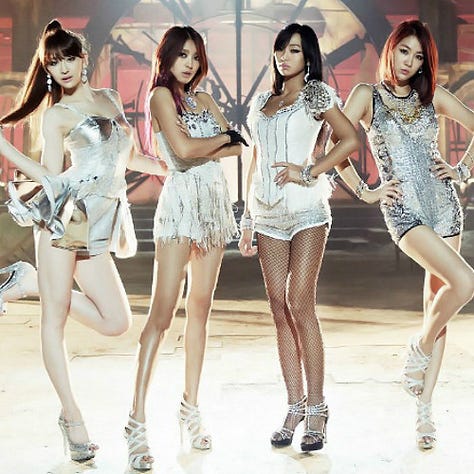


The ‘Cute and Innocent’ Concept
While the ‘sexy’ concept tended to use darker and stereotypically seductive colour palettes in its’ styling, ‘cute and innocent’ concepts utilised the opposite. Pastels and light colours such as baby pink, blue and white were almost exclusively worn, and high heels were swapped for flat shoes like Keds and Mary Janes.
An important factor in concept choice is the age of group members, as many K-Pop girl groups infamously debut with very young members. Recently debuted global sensations NewJeans released their first song when only 1 member out of 5 was over 18, the rest were between 14 and 17. As the K-Pop industry has developed, the prevalence of underage girls debuting in groups has increased - likely due to K-Pop companies’ goals of creating idols who can have the most lengthy and profitable careers possible.
The notion of watching young girls develop from ‘innocent and cute’ concepts, into mature and sexualised concepts, is an uncomfortable one – very much reminiscent of the ‘Lolita’ fantasy.
For example, GFRIEND, included two 17-year-olds and two 16-year-olds when they debuted with the song ‘Glass Bead’ in 2015. The music video was set in a high school, the members are shown dancing cutely and jumping on a trampoline in a high school gym. Their outfits were made to look like school uniform - maroon gym shorts and t shirts, matching white tennis skirts, ankle socks and preppy argyle cardigans. An appropriate theme for a group with underage members, but one that also clearly commodifies the appeal of ‘teenage innocence.’
In 2021 GFRIEND released ‘MAGO,’ which has a ‘retro/disco’ concept, in terms of its’ styling and choreography. The members wore sequined dresses in metallic hues, oversized earrings, feathers, and high heels with towering platforms. At one point in the music video, member Jeju, who was 17 when the group debuted, performs a pole dance routine while wearing sparkly pleasers, a crop top, and skin-tight booty shorts.
The issue this poses to feminism is not about GFRIEND’s Jeju and her choice of dancing and dressing in stereotypically sexualised way. It is the ‘girl to woman’ narrative that the groups’ timeline embodies. By creating a space that essentially provides time stamps for both ‘girl’ and ‘woman’ stages in the lives of female K-Pop idols that become of legal age whilst in the limelight, this ‘coming of age’ becomes overly sexualised.
Consider Billie Eilish, who turned 18 while in the public eye. She has been very outspoken about her choice to wear baggy and oversized clothing throughout her time as an underage performer, as to protect herself for inappropriate conversations circulating about her teenage body.
Ultimately, the ‘cute and innocent’ to ‘sexy’ concept timeline enables this, as it allows for a moment were a woman can officially be ‘legally’ over-sexualised - when she finally swaps her Mary Janes for stilettos. This is additionally exacerbated by ‘aegyo’ - a trend where K-Pop idols of all ages behave in a coquettish and cute manner, sometimes speaking in intentionally high pitched, child-like voices.
The women who have grown into their sexuality during their time as K-Pop performers have the right to express themselves however they want as adults. Unfortunately, the Korean beauty standard which idolises women that look very young creates a dilemma for these women. The sentiment of ownership over ones’ sexuality as an adult, is contextualised alongside them having been marketed for public consumption as a child.
It is the fact of the ‘sexy’ and ‘cute and innocent’ concepts’ existence as opposites, which presents this ‘Maddona versus whore’ dichotomy in K-Pop clothing styles, this is something which the ‘girl crush’ concept aimed to reject.
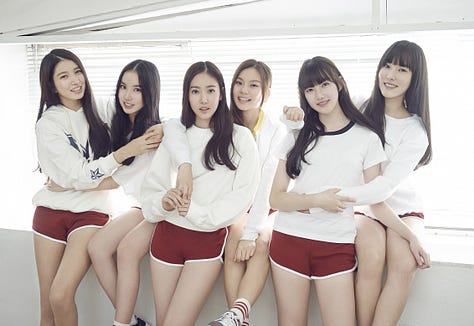




The ‘Girl Crush’ Concept
The ‘Girl Crush’ concept featured idols wearing a variety of different bright colours, rather than ‘provocative’ dark and moody tones, or ‘virtuous’ whites and pastels. Details such as leather, metal or PVC accessories were combined with ‘girlier’ items – such as the leather cage skirt worn over a blue button up shirt by CLC’s Elkie in the 2017 music video ‘Hobgoblin.’
Many female idols wore leather chokers, leg garters, harnesses and black over the knee socks. Music videos began combining elegant and stereotypically feminine outfits such as ball gowns, in the same videos as edgier, and more masculine looks - such as oversized graphic tee shirts and leather jackets.
These styles matched with the general trends of the period in fashion that the ‘girl crush’ concept became popularised in. They also integrally pivoted on juxtaposing ‘soft feminine’ items with utilitarian, motorcycle, and rock-chick aesthetics. For example, in Blackpink’s 2019 Kill This Love music video. Both Jennie and Jisoo wear light-coloured gowns in their solo scenes, and combat-style, dark coloured outfits featuring leg and body harnesses for the group choreography.
BLACKPINK famously epitomise the ‘girl crush’ concept, which they have never strayed far from. Their name, BLACKPINK illustrates this - they wear black and pink, embodying a take on traditional femininity which is simultaneously cute, sexy and empowered. Instead of being ‘innocent’ good girls or ‘sexy’ bad girls, they wear looks that are both stereotypically ‘good’ and ‘bad’ in the same 3-minute video.
Their debut album Square One, which was released in 2016 included the song BOOMBAYAH. In the music video, member Rosé wears a shirt that reads ‘beyond kawaii,’ perhaps just a graphic t-shirt, or maybe a message about their group representing something beyond cuteness - a modern vision of empowered female sexuality that has departed somewhat from the shackles of the male gaze? ‘Girl crush’ concepts still involve clear elements of stereotypically ‘male gazey’ clothing styles, but it was still a bold departure from the girl group concepts that were most popular previously.


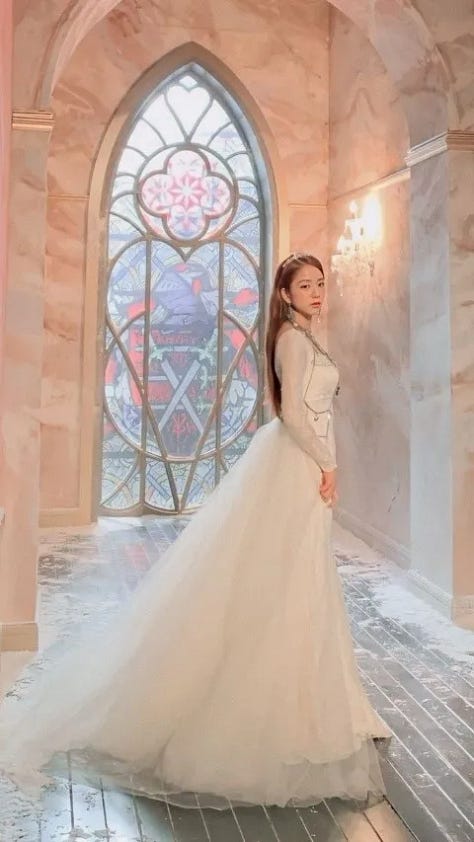
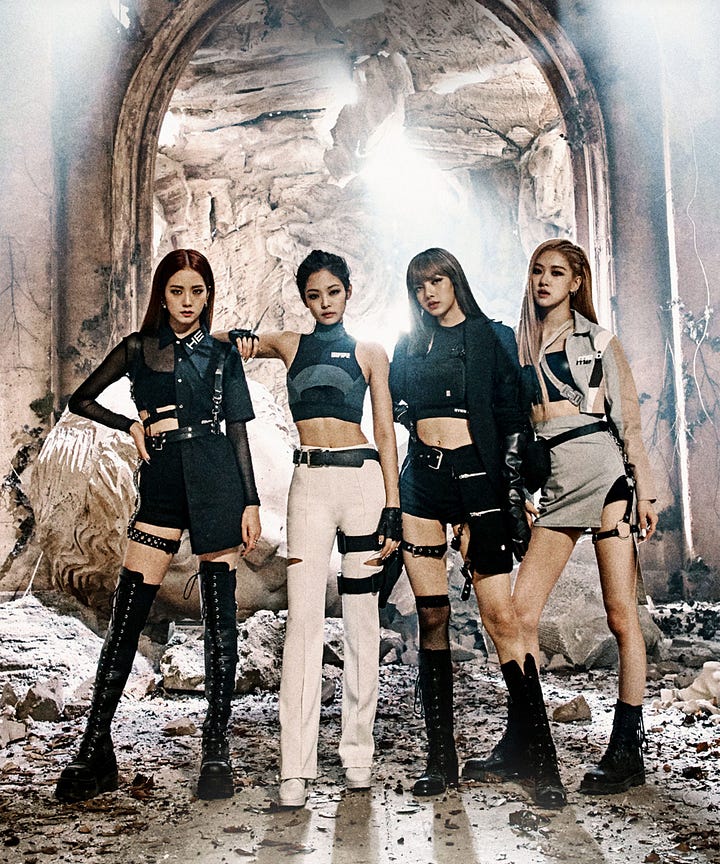

The Present and Future of Fashion and Feminism in K-Pop Girl Group Fashion
Where does this land us in 2023?
Replacing 'cute and innocent’ with fun and experimental: NewJeans’ styling in their second EP ‘Get Up’
Instead of exclusively ‘cute and innocent’ aesthetics, junior K-Pop girl groups such as NewJeans opt to display their youth through wearing vibrant, joyful, and unique outfits. In this way, the individuality of young women is represented and championed, rather than their ‘youthful innocence.’
In their music video ‘New Jeans,’ which was part of their 2nd EP ‘Get Up’ that was released in July, each member wore predominantly monochromatic bright outfits, inspired by the Powerpuff girls. Baby pink and white has been exchanged for animated and vivid blue, green, purple, yellow, and pink. The outfits were paired with crocs, Melissa jelly shoes, colourful socks, statement jewellery and butterfly hair clips - mixing retro clothing trends from the youth of the past and pairing them with contemporary styles.
In the ETA music video, the members wore oversized grey boiler suits for a dance scene set in a gas station. Haerin sported a puffy red heart crop top paired with angel wings, Hanni’s look was also accessorised by pink fairy wings and Minji wore a birthday cake printed dress.
The use of these youthful details and accessories do not attempt to conceal that the group is made up of teenagers. They are styled as teenagers who have fun with fashion and use clothing to represent their personalities. A stark contrast to their predecessors, who were more so characterised by one note - cuteness and innocence.
This notion of experimental style being part of contemporary teen culture, is mirrored by the adventurous and young designers that NewJeans wear in their videos – namely, Chopova Lowena, Collina Strada, Ottolinger, Chet Lo, Area, Shushu/Tong and Sandy Liang, just to name a few.
In the ‘Cool With You’ & ‘Get Up’ music video, NewJeans take a backseat in the videos’ storyline. They appear as guardian angels that watch over actress Jung Ho-yeon as she yearns for the love of man who she is seemingly invisible to. The members’ secondary role in this music video allows for the exploration of themes like, mature relationships and adult romance, while remaining appropriate for a group that includes members who are minors. This is also the format used in the ETA music video, where the storyline follows the members warning their friend, who is external to the group, to break up with her boyfriend.
Their guardian angel looks in ‘Cool With You’ & ‘Get Up’ feature oversized, floaty and ethereal draping, as well as elongated sleeves that create additional movement as they dance in the video. The delicate style, and subtle hue of their grey-toned dresses demonstrates the angelic characters they play in this video, without turning to over-sexualised ideas of ‘teenage innocence,’ or overly infantilising the members.



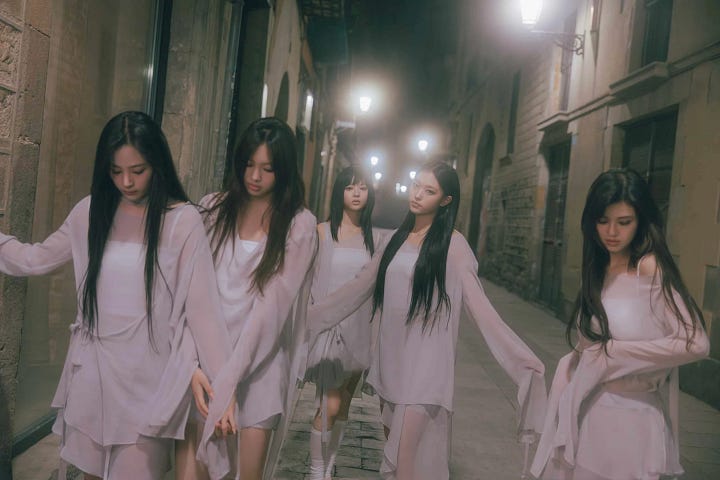
NewJeans - 'Cool With You' & 'Get Up'
Looking to the Past to Move Into the Future: (G)-Idle’s sexy but lighthearted take on Y2K style
Another prevalent trend in contemporary K-Pop girl group fashion is Y2K. (G)I-DLE’s ‘Queencard’ from June 2023 has been performed by the group in a multitude of different Y2K inspired outfits. Some authentically reference fashion trends from the 2000s and others utilise elements of throwback styles to create looks that are more playful and contemporary.
Some of the outfits worn by the group include miniskirts worn over trousers, Juicy sweat suits, tube dresses and double denim. Their styling took from both hyper feminine and masculine Y2K trends, and experimented with looks that champion a light-hearted sexiness, that remains mature. For example, in some performances they wore princess dresses, cheerleader outfits, butterfly wings and micro handbags. While in others, they sported timberlands, oversized shirts, workwear trousers and matching basketball shorts with ‘Queen-ca’ embroidered on the front
Some of these styling choices could verge on having junior or ‘innocent’ suggestions, but in combination with the more masculine styles worn, and considering the themes of the song and the choreography, it is clear that the group wore these outfits in a mature, empowered and adult context.
The song ‘Queencard’ and its accompanying song, ‘Allergy’ are based on the classic 2000s storyline of the popular girls versus the outcast, but ultimately (G)-Idle changes this narrative by concluding that every girl is a ‘queencard,’ and women should be confident in who they are and how they look.
The lyrics in the outro demonstrate this (translated into English):
‘A girl who’s thin or thick (girl)
Queenca-ca-card
A girl full of confidence (girl)
Queenca-ca-card’


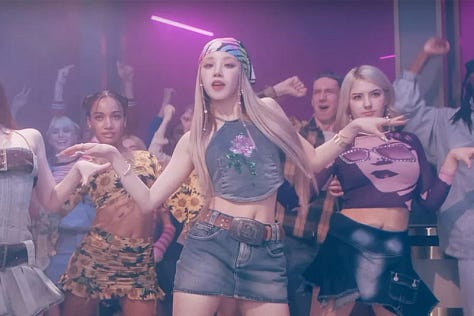
(G)I-DLE - 'Queencard' performance wearing princess dresses
Futuristic Fashion
Futuristic and other-worldly aesthetics are another element of the future of feminism in K-Pop girl group fashion. NewJeans, aespa and XG experiment with this, XG is a Japanese group that advertise in Korea but originated from a Japanese company, so they are more so a J-Pop than K-Pop group.
This is achieved by wearing a mix of avant garde contemporary designers like Windowsen, whose futuristic clothing has been seen on groups such as BLACKPINK, NewJeans and XG. As well as archival pieces, like shiny Courrèges trousers and jackets that are reminiscent of the matrix, worn by Aespa in their ‘Girls’ music video and Jean Paul Gaultier Cyber Dot Jumpsuits worn by XG in ‘TGIF.’
Futuristic elements such as nails that look like tentacles, ponytails so high they practically reach space, cropped jackets with structured and exaggerated shoulders, combinations of a variety of bright colours and extreme baggy trousers, are all featured as part of this girl-band from the future aesthetic. These looks are not always stereotypically ‘flattering,’ as they utilise shapes and silhouettes that drastically alter the slim figures that female K-Pop idols are famously required to have.




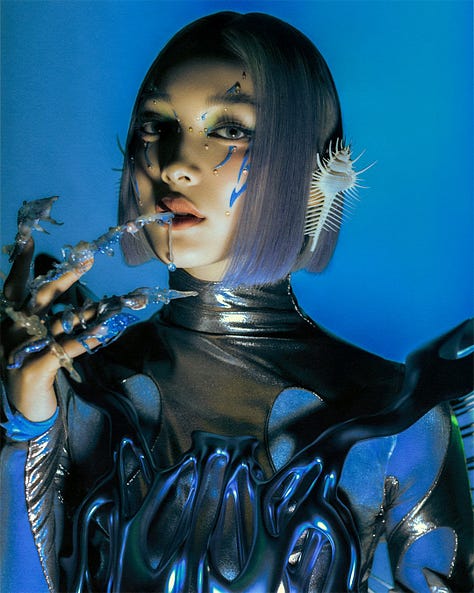

As members get younger, and impressive choreography becomes increasingly one of the most pivotal elements of K-Pop performances - trumping live vocals, stilettos and Mary Janes have been ditched for platform trainers and combat boots. The young women fore fronting the K-Pop industry are increasingly being allocated space for showcasing unique style and individuality, without having to conform to limiting and stereotypical concepts of femininity. Instead of being cute or sexy, K-Pop is making space for girl groups that represent more genuine expressions of female empowerment, whether these expressions involve overt sexualisation or not.



